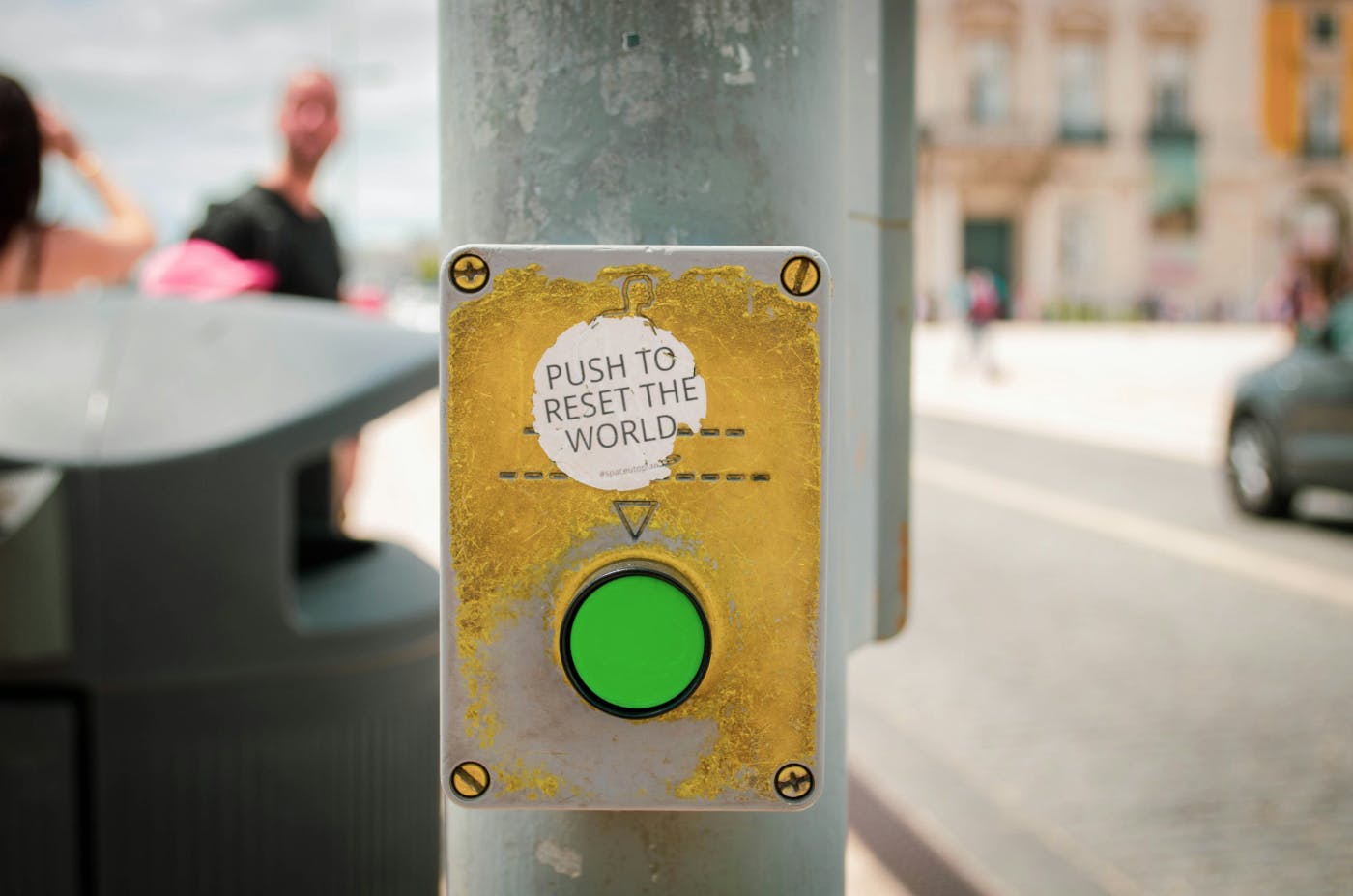

Some brands hit the point where tweaks and small updates aren’t enough. They need a full reset—a moment where they burn it all down to rebuild stronger, clearer, and more true to themselves.
Tim is a friend of mine. He’s a bit of a nebbish—or rather, he was. No, strike that, he still is. Deep down, where his heart of hearts lives, Tim is a nebbish. For those of you who didn’t grow up with a basic knowledge of Yiddish, a nebbish is a man regarded as pitifully ineffectual, timid, or submissive. The definition goes further: this person has no money, no prospects, a down-and-out kind of fella. Tim was not any of that. He had a good job, was fiscally responsible, lived well, and wasn’t being hounded by debt collectors. But he was timid, submissive, and if he were wearing pastels while visiting a Baskin-Robbins, he’d blend in with the decor.
Tim is a good guy, and he’s very aware of his nebbishness. He doesn’t wear it as a badge of honor, but he knows it’s there; he knows how he’s perceived. One day, I was sitting with Tim in a coffee shop when a woman walked up to our table, pointed at the chair he was sitting in, and asked if it was taken. That was the straw. The camel dropped, floundered, and Tim—well, he stood up, pulled the napkin from his collar, threw it on the table, and said, “That’s enough.” Then he stormed out. “So, the chair,” the woman said, and I followed Tim into the streets.
In the street, as Tim stood trying to hail a cab, he told me he had had enough of being overlooked, undervalued, and ignored. “This whole thing,” he gestured to himself, “this isn’t working, and now it’s time to burn it all down and recreate myself. No more will I be ignored.” Just then, a cab pulled up. The same woman from the coffee shop, the one who took his chair, slipped inside. “23rd, between Ninth and Tenth,” she said, and the cab drove off. Tim and I watched it melt into traffic. He turned to me, whispered through clenched teeth, “Mark my words,” and disappeared into the foot traffic.
A month later, I walked into that same coffee shop. There was Tim. Sitting with other people, talking, laughing, and a woman in the group even put her hand on his arm. “He did it,” I thought. “He changed his life, dropped the timid, unsure Tim, and has been reborn as…” I didn’t finish that thought because I didn’t know.
When he approached me, I said, “Tim, a woman touched your arm. I saw it with my own two eyes.” He nodded and began recounting his adventures over the last month: he joined a gym, started seeing a therapist, built a social life, and yes—the woman who touched his arm was now his girlfriend. Not proud, not excited, just matter-of-fact. “I’m terrified of her,” he admitted. Turns out, Tim had changed on the surface—new clothes, new habits, new social experiences—but deep inside, he was still Tim. Surface-level change only takes you so far. And that, I realized, is a good thing. I like Tim.
But watching Tim’s attempted transformation got me thinking about brands. Some brands hit the point where tweaks and small updates aren’t enough. They need a full reset—a moment where they burn it all down to rebuild stronger, clearer, and truer to themselves. Just like Tim, the outward makeover isn’t the whole story; the core still matters.

Why Brands Hit the “Burn It Down” Point
Just like Tim, brands can reach a moment where nothing seems to work. Minor tweaks—slightly brighter colors, a fresher logo, a catchier tagline—might temporarily distract, but the underlying problem remains. The brand feels invisible, misunderstood, or irrelevant, even to the people who run it.
There are a few common reasons brands end up here:
1. Market Relevance Has Drifted Away<br />Audiences change. Culture shifts. What once felt cutting-edge now feels dated or even tone-deaf. For Tim, it was the simple moment in the coffee shop—the world wasn’t noticing him. For brands, it might be a product line no one buys, a website that feels stuck in the last decade, or messaging that doesn’t speak to the current audience. The signal is clear: “You don’t fit here anymore.”
2. Internal Misalignment or Confusion<br />If a brand’s own employees can’t explain what it stands for, or if departments are sending conflicting messages, the brand is fragmented. Tim knew he was timid, but he had no plan for being noticed—or being heard. Similarly, a company might have pieces of a brand—logos, slogans, campaigns—but no cohesive identity to unify them.
3. Reputation or Crisis Forces a Rethink<br />Sometimes it’s not a slow drift—it’s a sudden jolt. Scandal, public backlash, or a missed cultural moment can demand a hard reset. Tim didn’t face a public scandal, but that coffee-shop incident was his jolt—his tipping point. For brands, crises force clarity. They either respond with meaningful change or risk fading away entirely.
4. Strategic Pivot or Growth<br />Mergers, acquisitions, or entirely new business directions can make old branding feel like a misfit. Tim’s month-long self-reinvention was his pivot. He joined a gym, went to therapy, and entered a world of new social rules. For brands, a pivot might involve entering a new market, launching a new category, or shifting the core business. The old identity simply won’t fit the new reality.
The common thread? Whether Tim or a multinational brand, the pattern is the same: incremental tweaks aren’t enough when the core identity is misaligned with the world it inhabits. That’s when you face the choice: continue treading water, or burn it all down and start over. Some brands have taken that leap, dismantling what everyone thought they were and rebuilding from scratch. The results, in some cases, are dramatic—reinventions that capture attention, redefine relevance, and even rewrite history. And just like Tim’s attempt to reinvent himself, the story of a brand hitting reset is never just about surface-level change—it’s about confronting the core of who they are and who they want to be.

Who Did It, Why They Did It, and How It Worked
Some brands have stared down the same kind of crossroads Tim faced: a hard choice between sticking with the familiar or taking a daring leap. Take Burberry in the early 2000s. Once a stodgy, traditional British heritage brand, it had lost cultural relevance. Younger consumers saw it as outdated, overexposed in ways that cheapened the cachet, and internally, its identity was murky. The brand knew small tweaks wouldn’t cut it—it needed a full reset.
Burberry’s leadership didn’t just tweak the logo or release a new coat—they redefined the brand’s essence. They brought in a fresh creative vision, modernized design, overhauled marketing campaigns, and reintroduced the brand as a cultural icon. Every change, however visible, was rooted in a deep understanding of what Burberry stood for: British heritage, craftsmanship, and aspirational luxury. The reinvention worked: sales soared, brand perception shifted, and Burberry became culturally relevant again without losing its soul.
Then there’s Domino’s Pizza, whose brand story is almost the inverse. Faced with declining customer satisfaction and mounting criticism over taste, the company didn’t hide behind slogans or ads. They publicly acknowledged the problem, demolished their old recipes, and rebuilt the product from scratch. Every pizza was rethought, every process improved, and the campaign didn’t shy away from the honesty of “we know we weren’t perfect.” Customers noticed. Loyalty returned. The brand’s credibility grew precisely because it embraced the burn-it-down mindset authentically.
Even smaller, seemingly “safe” brands can benefit from the same strategy. The common thread? It’s never just about cosmetic change. Just as Tim’s month-long reinvention wasn’t only about new clothes or gym sessions, a brand’s reset must confront its core identity, acknowledge past failures, and redefine its purpose. Surface changes alone rarely produce lasting impact.
Looking at these examples, a pattern emerges: successful resets combine self-awareness, boldness, and authenticity. They don’t just put on a new coat—they examine what’s underneath, confront what isn’t working, and rebuild with clarity. And yet, as Tim’s story reminds us, a reset is risky. Change can be uncomfortable, even terrifying, because it asks the brand—or the person—to meet the world with honesty rather than pretense.
Lessons for Brands Considering a Full Identity Reset
If Burberry and Domino’s teach us anything, it’s that a full brand reset isn’t a cosmetic exercise—it’s a deep, sometimes uncomfortable process. There are lessons lurking in their stories, lessons that any brand contemplating a burn-it-down approach would do well to heed.
1. Confront the Core Honestly<br />Tim’s reinvention didn’t stick because he simply wore new clothes or joined a gym. He had to face his timid, overlooked self and decide how he wanted to exist in the world. For brands, that means digging into the messy truth: what’s working, what isn’t, and why. Cosmetic fixes, like minor logo tweaks or slogan rewrites, can’t cover up structural problems.
2. Be Bold, But Authentic<br />Domino’s didn’t just tweak the recipe—they tore it down publicly, owning past mistakes. Burberry didn’t abandon its heritage—they amplified it through a modern lens. Bold moves resonate only when they are authentic; audiences can smell pretense. A reset that feels inauthentic is worse than no reset at all.
3. Plan the Experience, Not Just the Aesthetic<br />Reinvention isn’t just about what people see—it’s about how they experience the brand. Tim’s social experiments—joining gyms, dating, trying new routines—created real change in how the world interacted with him. For brands, every touchpoint counts: packaging, service, digital presence, advertising, and even internal culture. Each must align with the new identity.
4. Accept the Risk<br /> Burning it down is scary. You can’t control exactly how people will react. Tim was terrified of Candace, unsure if his new persona would actually take hold. Brands face similar uncertainty: will customers embrace the change, or will they rebel against it? The difference between a successful and failed reset often lies in courage tempered by insight.
By keeping these lessons front and center, brands can navigate the reset without losing their essence—or alienating the audience they hope to win back. The act of starting over is not a failure; it’s an opportunity to reconnect with purpose, to emerge sharper, more relevant, and more memorable.
And just like Tim eventually found a balance between his old self and his new life, a brand that embraces a thoughtful reset can emerge both renewed and authentic—ready to meet the world in a way that truly resonates.

When a Full Reset Isn’t Necessary
Not every brand needs to light the match and watch everything burn. Sometimes, small, intentional adjustments are enough to regain relevance without risking the identity that already works.
Tim’s story reminds us of this, too. After his month-long adventure, he didn’t completely abandon who he was. He added confidence, tried new routines, and explored new social spaces—but at his core, he remained Tim. The surface changes mattered, but they only worked because they were built on an existing foundation.
Brands operate the same way. Take Starbucks in the mid-2000s. The company wasn’t failing, but growth had slowed, and customer experience was inconsistent. Instead of a complete reinvention, Starbucks made targeted, thoughtful changes: improving store design, refining menu options, investing in barista training, and enhancing loyalty programs. The identity remained intact, but the experience was revitalized. Customers noticed. Sales climbed. Brand perception improved.
The key lesson here is discernment. A reset is expensive, risky, and emotionally intense—both internally for employees and externally for customers. Incremental change can be far more strategic if the brand’s core identity is still strong and relevant. Burn it down only if the foundations themselves are crumbling or no longer resonate. Otherwise, tweaks, refinements, and purposeful evolution may do the trick.
And just like Tim, who now walks confidently yet still carries his nebbish heart, brands can evolve meaningfully without abandoning the essence that makes them recognizable and loved.
Risks and Pitfalls: The Burn-It-Down Danger Zone
Burning everything down can be exhilarating, but it’s not without hazards. Tim’s month-long reinvention wasn’t all triumph—he stumbled, felt terrified, and occasionally wished he could retreat to his old, comfortable self. Brands face the same tension: the leap is high, and the landing is uncertain.
Mistakes often happen when a reset is superficial, rushed, or disconnected from reality. A brand might chase trends without understanding its audience, adopt a shiny new identity without internal alignment, or change messaging faster than the market can digest. The result? Confusion, alienated customers, and wasted resources.
Even worse is the trap of over-correction. Some brands, like Tim, might try to be something they aren’t, throwing out everything familiar in a desperate bid for relevance. Without a clear sense of identity at the core, a reset can backfire, leaving the brand unrecognizable and lost.
The lesson is simple but crucial: a burn-it-down approach demands courage, clarity, and self-knowledge. Only when the foundations truly need rebuilding—and when the brand is willing to engage thoughtfully with the process—does a full reset become a strategic move rather than a gamble.
With that in mind, it’s time to step back and reflect on the bigger picture—what it all means, and how brands can approach reinvention without losing their essence.

Summing Up
Tim’s story isn’t just a quirky anecdote about a nebbish trying on confidence—it’s a mirror for brands contemplating reinvention. Burn it down, or tweak it? Leap boldly, or evolve incrementally? The answer always starts with understanding the core of who you are.
Brands like Burberry and Domino’s show that bold resets can work—but only when they’re rooted in authenticity, guided by insight, and executed with courage. At the same time, Starbucks reminds us that sometimes subtle evolution achieves the same goal without the risk of upheaval. And everywhere in between, the pitfalls loom: over-correction, superficial changes, or rushing without clarity can turn reinvention into a misstep.
The truth is simple: reinvention is a tool, not a reflex. It’s about asking the hard questions, embracing the uncomfortable, and knowing when to rebuild and when to refine. Like Tim, brands carry an essence that can’t—and shouldn’t—be burned away. But with careful attention, thoughtful strategy, and a willingness to face what’s really inside, a brand can step into the world renewed, relevant, and undeniably itself.
For more insights on navigating creative change under pressure, check out ThoughtLab’s latest, Process Over Panic: A Creative Survival Strategy, which digs into how structured thinking and smart process can turn risk into opportunity.
